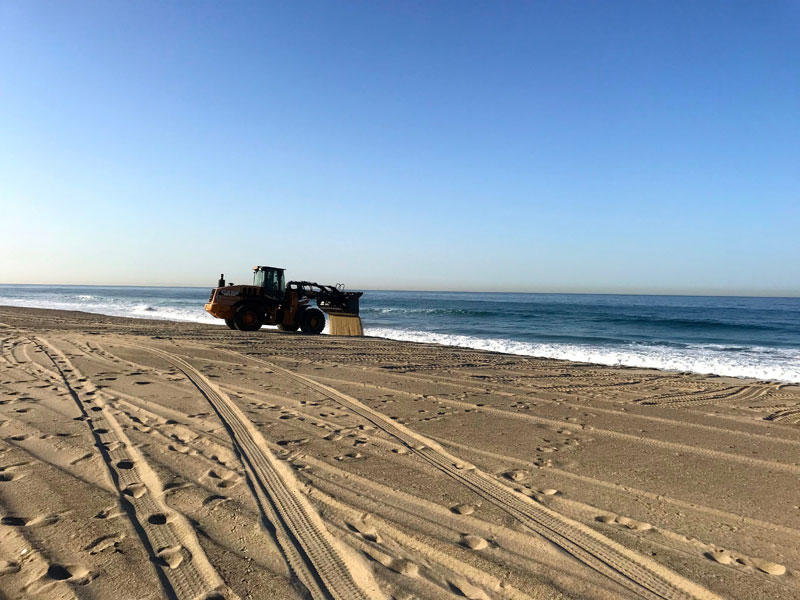
Beach renourishment. Photograph: © SAF — Coastal Care.
“Development is absolutely responsible for the majority of the beach nourishment,” Andrew Coburn, assistant director of The Program for the Study of Developed Shorelines at Western Carolina University, said. “Well over 99 percent of the shorelines that are nourished are developed so there is some economic value placed behind them.”
Excerpts;
Supplemental sand may have saved a North Carolina beach from Hurricane Florence, but some say the projects aren’t worth it…
“Within a decade or two or three, it depends on where you are, we’re looking for a time when beach nourishment doesn’t work, so what do we do next?” asked Orrin Pilkey, an emeritus geology professor and coastal expert at Duke University. “Nobody, I don’t think, is thinking about how, when sea level rises, beach nourishment will be out of the question, will be economically impossible…”
Read Full Article; Guardian UK (09-20-2018)
Can Adding Sand to Beaches Save Them? How Stuff Works (04-13-2018)
The question is, can beach nourishment keep up with the ever-increasing forces of climate change or, like Sisyphus forever pushing his boulder up the hill, is adding sand to beaches an expensive, temporary fix to a long-term problem?..
Coastal geologist criticizes beach renourishment efforts; By Robert S. Young, PhD; The State (08-17-2016)
Rob Young, who heads the Program for the Study of Developed Shorelines at Western Carolina University, said the government is subsidizing coastal development with renourishment money – and that’s costing taxpayers. Communities across the country have spent millions of dollars renourishing beaches. Those efforts encourage people to rebuild after every major hurricane…
Palm Beach Mid-Town Dredge Project, A Youtube Video (02-04-2015)
“Beach nourishment projects like this have become commonplace along the US East and Gulf Coasts. These projects have immediate environmental impacts through burial of nearshore habitat and increased turbidity during project placement.The cumulative environmental impacts of doing this repeatedly on the same beach while conducting projects from Maine to Texas is unknown. But, we should be concerned. ” —Robert S. Young, PhD, Director, Program for the Study of Developed Shorelines, Professor, Coastal Geology, Western Carolina University
Piling sand to stop erosion ultimately made the land sink, study says, NOLA (12-26-2015)
Is pumping more sand onto NC beaches causing deadly currents?; The News & Observer (08-30-2018)
A growing number of scientists and coastal engineers worry that there’s a serious downside to beach nourishment: Unnaturally altered beaches could pose an elevated risk of injury to the very tourists that sand replenishment was meant to attract…
A wider, deeper beach awaits Ocean City vacationers, but is it safe? The Washington Post (06-01-2018)
Ocean City vacationers may notice deeper, wider beaches, the result of a $282 million sand-dredging project aimed at protecting the resort town from storm damage. But the work also raises concerns about surf injuries and swimmer safety…
Widening beaches might bring more hazards, researchers say; Sun Sentinel (04-04-2018)
Widening beaches might be linked to an increase in accidents, according to new data. The number of ocean rescues spikes after beaches are buffed up, according to the data published in the Journal of Ocean Research…
Sea level rise has already sunk Carolinas beach property values — by $1.6 billion, study finds; News & Observer (07-25-2018)
Sea levels are rising and the southeast has already lost billions in property value, a recent study shows. Scientists have found $7.4 billion was lost in home values across North Carolina, South Carolina, Virginia, Georgia and Florida because of sea level rise flooding from 2005 to 2017…
Beach replenishment may have far reaching impacts on ecosystems;” Phys.Org (03-29-2016)
UC San Diego biologists who examined the biological impact of replenishing eroded beaches with offshore sand found that such beach replenishment efforts could have long-term negative impacts on coastal ecosystems…
“Seawalls Kill Beaches,” Open Letters by Warner Chabot And Rob Young, (10-03-2014)
Surrendering to rising seas; Scientific American (08-2018)
Coastal communities struggling to adapt to climate change are beginning to do what was once unthinkable: retreat…
The only answer to rising seas is to retreat; By Orrin H. Pilkey & Keith C. Pilkey; The News & Observer (10-18-2017)
Except for the timing, there is no controversy among scientists regarding sea level rise. Defending the coast and holding the shoreline in place ultimately will be futile. With a three-foot or a six-foot sea level rise, we will retreat, probably beginning within the next 50 years…
Let’s end war with ocean, Op-Ed by Orrin H. Pilkey (04-2017)
The immediate future most certainly holds more miles of sandbags, resulting in more narrowed and ugly beaches.But this trend can be halted and reversed. Now is the time to make peace with the ocean.The time is now to stop sandbagging, both physically with no more shore-hardening structures, and politically with no more exceptions to the intent of the rules, no more undermining existing legislation, and a return to enforcement…









